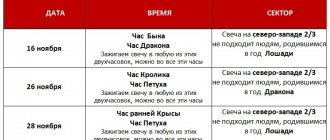An ancient Chinese proverb says: “ Take food as medicine, otherwise you will take medicine like food.”
" Just from these words it is clear how seriously nutrition is taken in TCM (traditional Chinese medicine). After all, we should get vital energy from food, but instead, many eat in such a way that they do not gain energy, but destroy it. Medical nutrition is used by Chinese medicine specialists when a person is already sick, but anyone who wants can use energy-balanced everyday nutrition.
Proper daily nutrition according to the 5 elements system eliminates mild imbalances in the body and simple symptoms, helps maintain a cheerful, active state and good mood. The basis of this diet is balanced food, appropriate to the time of year, which is suitable for all family members.
Table No. 11
Recommendations for product types
Indications:
- tuberculosis of the lungs, bones, lymph nodes, joints with a mild exacerbation or its attenuation, with low body weight;
- exhaustion after infectious diseases, surgery, injuries.
Diet: 4–5 times a day
Duration of appointment: 1–2 months or more
Nutrition Features:
The diet has a high energy value with a high content of proteins, minerals and vitamins.
Table No. 3
Recommendations for product types
Indications:
- chronic diseases and functional bowel disorders accompanied by constipation.
Diet: 4–5 times a day
Duration of appointment: unlimited
Nutrition Features:
Food is prepared mostly unchopped, boiled in water or steamed, or baked. Vegetables and fruits are consumed raw or boiled. The diet includes cold first and sweet dishes and drinks.
Five Elements Theory
According to this theory, the energy value of foods is determined by their color and taste characteristics. What are the main tastes of food in our mouth? That's right, sweet, bitter, spicy, sour, salty. And each of them affects our body in its own way.
Spicy taste.
It warms and easily copes with colds and congestion. The list of products with a spicy taste: arugula, sage, cauliflower, radish, garlic, kohlrabi, onions, fennel, asparagus, cinnamon, millet, coriander, bran.
Sour taste
. As Chinese nutritionists say, sour taste preserves all the juices of our body. It stimulates appetite and reduces thirst in the summer heat, after physical activity and sports training. Acidic foods can direct energy downward, so to relieve aggression or irritation in your interlocutor, offer him, for example, an orange. Acidic foods normalize blood pressure, maintain vascular tone, fight germs and improve digestion. Here are some of them: apple, lemon, apricot, orange, currant, cranberry, tomato, gooseberry, sorrel, yogurt, kvass, vinegar.
Salty taste.
There is some duality in this group: on the one hand, salty foods provoke the accumulation of excess fluid in the body, on the other, they cope well with edema. They perform a detox function and have a relaxing effect. Salty foods move energy down and have a laxative effect. The most popular representatives of this group are seafood.
Bitter taste.
Green tea, black tea, cocoa, natural coffee, lamb are some examples of bitter foods. They have diuretic properties, have anti-inflammatory and tonic effects, and relieve fever. But pay attention. The bitter taste dries out and by consuming large amounts of coffee, black tea (let’s add smoking here too), we provoke pathological dehydration, trigger the process of premature aging of the skin and the appearance of wrinkles.
Sweet taste.
Products from this group relieve tension, stress, pain, strengthen muscles, tone the body and restore order to our inner harmony. It includes honey, banana, melon, carrots, beets, figs, corn, beans, celery, peas, potatoes, wheat, pumpkin, vegetable oils, rice, veal, duck, chicken, beef, trout. Sweet taste is considered the most important - it most replenishes missing energy. Now those with a sweet tooth will exclaim: “Oh, yes! We will continue to indulge in our favorite sweets and cakes!” This is a huge misconception, which ultimately leads to weight gain. Why? 100 grams of dark chocolate contains 530 calories, but according to the principles of Chinese dietetics, it is energetically empty, there is no Qi in it. Moreover, it is the lack of Qi that causes addiction to “unhealthy” sweets.
Chinese nutritionists compare the tastes of foods with our organs. Sour taste is associated with the liver, bitter taste is associated with the cardiovascular system, salty taste is associated with the genitourinary system, and sweet taste is associated with the spleen. Organs do not function separately; they are an interconnected system in which everyone supports each other. The liver stimulates the heart, which controls the spleen and pancreas, and the lungs look after the kidneys, which in turn influence liver function.
By including foods from the taste list in our daily diet, we can help our organs cope with their tasks. According to Chinese dietetics, bitter and sour foods are good for a weak heart, bitter and sweet foods are good for the gastrointestinal tract, the kidneys need spicy-sweet tastes, and the liver needs sour-salty ones. Perhaps these statements diverge from our usual ideas, but, nevertheless, they are true.
Product color - organ
Let's sort the products by color and find out which organ corresponds to them.
Green color/sour taste
- liver. As you already understood, these are greens, cucumbers, spinach, peas, and kiwi. Green foods support normal liver and gallbladder cells. They reduce mental stress, physical fatigue, relieve headaches, and stimulate vision.
Red color/bitter taste
- heart. Yes, foods of this color support heart function. They strengthen the nerves, help cope with bad moods, reduce anxiety and stress, and increase the level of resistance of the body. These are red wines, apples, cherries, watermelon, poultry, red fish, shrimp.
Yellow color/sweet taste
correspond to the spleen and pancreas. Yellow foods are food for a good mood. Without it, it is difficult to resist the blues and stress. It is an excellent antioxidant and detox agent. By using it, you can improve memory and attention. It is high in vitamins A. Yellow foods include pumpkin, carrots, corn, lemons, bananas, oranges, and tangerines.
White color/sharp taste
– respiratory system, lungs. Food of this color warms our body from the inside. She is a source of energy and heat. In our diet it is represented by potatoes, garlic, turnips, rice, coconut, almonds.
Black color/salty taste
– urinary system, kidneys. Grapes, eggplants, mushrooms, legumes, seaweed - these products are a real treasure for the health of the kidneys, liver, skin and hair. They contain about 20 amino acids, a dozen minerals, essential vitamins, and linoleic acid. The Chinese claim that it is “black” foods that slow down the aging process.
It is more correct to consume the above products in the first half of the day, when the activity of the gastrointestinal tract is maximum. The Chinese say that it is the gastrointestinal tract that is responsible for the redistribution of energy within us. Its amount is directly proportional to the level of metabolism. Calories are not energy at all. Remember the example with the chocolate bar.
Table No. 9
Recommendations for product types
Indications:
- mild to moderate diabetes mellitus;
- establishing tolerance to carbohydrates;
- selection of doses of insulin or other drugs.
Diet: 5 times a day
Duration of appointment: sometimes for life
Dietary features: dishes are served boiled, baked, steamed, fried - to a limited extent.
Table No. 0
Recommendations for product types
Indications:
- undergone surgical interventions on the gastrointestinal tract
- rehabilitation of patients in the intensive care unit
- cerebrovascular accident
- after traumatic brain injury
- for patients with infectious diseases who are in serious condition.
Diet: 5–8 times a day
Duration of appointment: as needed
Nutritional features: this diet is designed to restore the patient’s vitality, replenish nutrients and increase the overall resistance of the body. The diet is very strict.
Table No. 7
Recommendations for product types
Indications:
- acute nephritis in the recovery phase;
- chronic nephritis without exacerbation;
- nephropathy of pregnant women and other diseases requiring a salt-free diet.
Diet: 4–5 times a day
Duration of appointment: long
Nutritional features: the diet is complete, practically no different from the diet of a healthy person. Patients are advised not to abuse protein foods (up to 0.8–0.9 g/kg) and somewhat limit salt (7–8 g/day).
Table No. 7a
Indications:
- acute and chronic nephritis in the acute stage;
- terminal chronic renal failure.
Diet: 5 times a day
Appointment period: several days
Nutritional features: modification of the basic diet with the complete exclusion of salt, severe restriction of fluid and protein.
Table No. 7b
Indications:
- recovery period after acute kidney inflammation;
- CRF.
Diet: 5 times a day
Duration of appointment: from several days to several months
Nutritional features: modification of the basic diet with restriction of salt and protein, is transitional from No. 7a to No. 7
Tables No. 7v and No. 7d
Prescribed to persons with severe nephrotic syndrome and those on hemodialysis, respectively.
They represent a modification of the basic diet with increased protein content.
Table No. 1
Recommendations for product types
Indications:
- peptic ulcer of the stomach and duodenum in the acute stage and unstable remission;
- acute gastritis;
- chronic gastritis with normal and high acidity in the stage of mild exacerbation;
- gastroesophageal reflux disease.
Diet: 4–5 times a day
Duration of appointment: at least 2–3 months
Nutrition Features:
Dishes are served in a semi-liquid or jelly-like form, warm; meat dishes and potatoes are cooked without frying. Limit the content of table salt.
Table No. 1a
Modification of the main table with a strict gentle diet that protects the gastric mucosa. This diet involves eating food in liquid, mushy and jelly-like form.
Indications:
- stomach and duodenal ulcers (severe exacerbation);
- exacerbation of chronic gastritis with severe pain;
- condition after gastrointestinal bleeding (after a strict gentle diet).
Diet: 5–6 times a day
Appointment period: several days
Recommended: milk, mucous cereal milk soups with butter; liquid, pureed, milk porridges; soft-boiled eggs or steam omelettes; steam soufflés from lean varieties of fish and meat; unsalted butter or olive oil, cream; berry, fruit (non-acidic) and milk jelly, carrot, fruit juices, rosehip decoction, weak tea with milk.
Salt is limited to 5–8 g, liquid - to 1.5 liters. Additionally, vitamins A, C, and group B are prescribed.
Table No. 1b
Prescribed to ensure a smooth transition from a strict gentle diet to a basic diet.
Indications:
- subacute phase of peptic ulcer and exacerbation of gastritis.
Diet: 4–5 times a day
Appointment period: several days
Nutritional features and products:
The food is prepared in a puree form, 75–100 g of crackers from premium white bread, meat and fish in the form of cutlets, quenelles, and meatballs are added. More often they give pureed milk porridges. Milk and cereal soups.
Table No. 5
Recommendations for product types
Indications:
- chronic hepatitis with a benign and progressive course;
- liver cirrhosis without exacerbation;
- chronic cholecystitis;
- cholelithiasis;
- acute hepatitis and cholecystitis during the recovery period;
- other diseases accompanied by dysfunction of the liver and biliary tract.
Diet: 5 times a day
Duration of appointment: unlimited
Nutrition Features:
Dishes are mostly boiled or baked after pre-cooking. Food is prepared mainly in uncut form. Flour and vegetables for dressing are not fried, but dried.
Table No. 5a
Indications:
- acute hepatitis and cholecystitis;
- exacerbation of chronic hepatitis, cholecystitis, liver cirrhosis.
Diet: 5 times a day
Appointment period: several days
Nutritional features: nutrition is the same as with diet No. 5, but you should eat more protein-containing foods, limit foods containing fats and carbohydrates; dishes that enhance the processes of fermentation and putrefaction in the intestines, strong stimulants of bile secretion and substances that irritate the liver.
Dishes are prepared boiled, pureed, and served warm. Separate baked dishes of meat and fish, pre-boiled, without crust, are allowed.
Table No. 15
Recommendations for product types
Table No. 15 is indicated for diseases in which there is no need for therapeutic diets. This diet is physiologically complete, while spicy and hard-to-digest foods are excluded. You should consume 90 g of protein, 100 g of fat and 400 g of carbohydrates per day. You can eat almost all foods, except for fatty poultry and meat, mustard, pepper and refractory fats of animal origin.
Indications:
- diseases that do not require a special diet
Diet: 4 times a day
Duration of appointment: unlimited
Table No. 8
Recommendations for product types
Indications:
- obesity as a primary disease or concomitant with other diseases that do not require special diets.
Diet: 5–6 times a day
Duration of appointment: long
Nutrition Features:
Reducing the caloric content of the diet due to carbohydrates, especially easily digestible ones. and, to a lesser extent, fats (mainly animal) with normal protein content. Restriction of free fluid, sodium chloride and appetite-stimulating foods and dishes. Increased dietary fiber content. Dishes are prepared boiled, stewed, baked. Use sugar substitutes for sweet foods and drinks.










